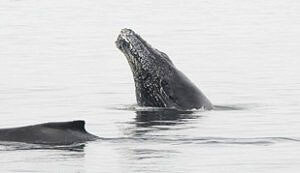Acrobatics and percussion: breaching, porpoising, lobtailing, bellyflopping
With its spectacular leaps out of the water, the humpback whale is the champion of breaching. It is estimated that this dazzling behaviour represents the maximum physical exertion of the whale. Imagine then when this feat is performed in succession, up to 130 times in 75 minutes! During a dorsal breach, 90% of the body leaves the water after breaking the surface at 15 knots, all on an axis of 30° from the vertical, then a half-twist in the air and the whale lands on its back! … a landing on the underside and it’s a “bellyflop”. These leaps should not be confused with porpoising, which is a series of horizontal jumps performed at high speed by numerous smaller species of whales. It is thought that this behaviour helps whales swim faster while minimizing energy losses, since it is easier to slice through the air than it is the water. As for “lobtailing”, this consists of repetitively and noisily slapping the tail on the water surface.
According to a study by American researchers, breaching could also improve the diving ability of young humpback whales. Indeed, the physical effort to achieve this feat would influence the production of myoglobin. Myoglobin carries and stores oxygen in the muscles of vertebrates. Among marine mammals, it is particularly abundant and would be the key to the success of their dives.


